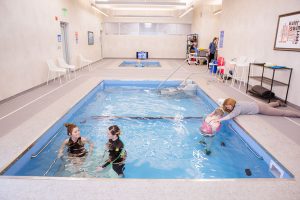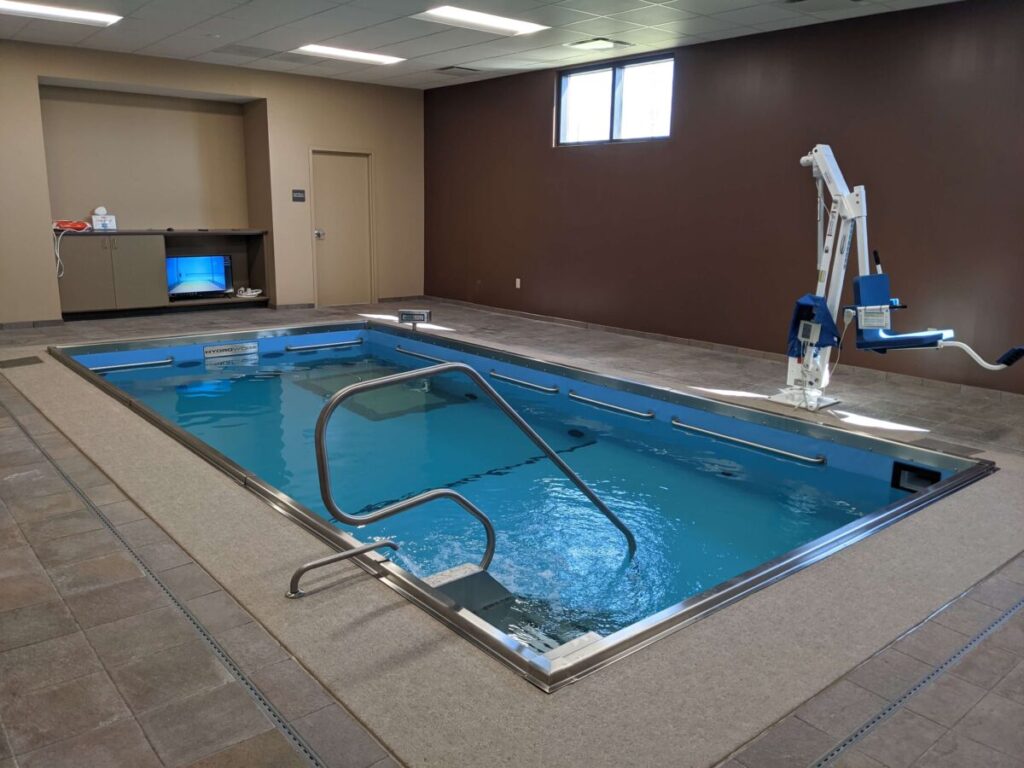Starting An Aquatic Therapy Program: Q&A With Rock Valley PT

Rock Valley Physical Therapy in Davenport, IA set out to answer these questions as they began their aquatic therapy program, which proved to be not as overwhelming of a process as it may seem.
Now we just love the pool. It’s blown up even quicker than we expected. Patients enjoy it and talk about it to their friends and their medical providers. We’re thrilled with the investment.
-Becky Burke, PT, DPT, GCS of Rock Valley PT
In this interview, Becky Burke, PT, DPT, GCS of Rock Valley PT, shared how and why they invested in an aquatic therapy pool, and how it positively impacted their patients and the future of the clinic.
Before offering aquatic therapy at their clinic in Davenport, IA, the Rock Valley Physical Therapy team met their patients at a nearby YMCA pool for appointments. The YMCA gave Rock Valley access to the pool from 1pm-4pm four times a week. This was helpful for the team to get started with aquatics, but soon presented challenges for meeting the service’s increased demand.
Q: Why did you choose to bring your aquatic therapy services in-house? What have been the results of that change?
Becky: “[Utilizing the YMCA] was a great start but limited our ability to increase our patient volume. It was a difficult timeslot for our younger patients—our student athletes couldn’t come and many people work in the middle of the day. Now that we have a pool on-site, we see about 40 patients per week in the pool.”
Knowing their clinic has a wide variety of patient needs, it was crucial for Rock Valley PT to choose the right aquatic therapy pool, which is why they did their homework before deciding which one was best for their needs.
Q: What steps did you take when choosing your aquatic therapy pool?
Becky: “Through CE classes, I knew about HydroWorx and that they provided pools. I just looked at different types of companies and different types of pools. Then I went to visit a HydroWorx pool. We liked the treadmill aspect for our patient population. Now we just love the pool. It’s blown up even quicker than we expected. Patients enjoy it and talk about it to their friends and their medical providers. We’re thrilled with the investment.”
After Rock Valley PT identified its greatest needs and clinic goals, the team chose the HydroWorx 3500 for its aquatic therapy program.
Q: How has HydroWorx 3500 helped you work with patients who may not have otherwise tried aquatic therapy?
Becky: “Getting people in the pool, it’s all about education. I have aquatic patients who can’t swim and are initially very uncomfortable in the water. We have 3’ 5” and 5′ depths in our pool, and I tell them that if they are concerned, we can stay in the shallow part. They use the grab bars at first then we slowly remove them. We can get in the pool with them and use gait belts when needed. The key is putting them at ease and developing trust. Sometimes it takes a couple of visits.”
When Rock Valley PT moved its aquatic therapy services into its clinic for patients, it also transitioned a secondary source of income under the same roof: a private pay program.
Q: What is your private pay program? How has it benefitted your clinic?
Becky: “Prior to having the HydroWorx pool, we developed a private pay “maintenance” program for our geriatric patients. They used the YMCA pool as part of an independent exercise program upon discharge. We carried that over when we moved and bought our pool. Now, we have two hours blocked out every day for our maintenance program. Some of these “maintenance” members have been doing aquatic therapy for almost 10 years.”
Q: Could you share a memorable patient story with us?
Becky: “We have a patient with a very complex medical history, with multiple falls, a hip fracture, and a neurological diagnosis. When she came for her initial evaluation, she couldn’t stand for more than 10 seconds without needing to sit. She was very apprehensive about getting in the water, but we encouraged her to try.
We got her moving in the pool. The first barrier was pain. The pool helped greatly—she moved pain-free in the water. It provided something no other modality could, with the unweighting of her joints and the principles of water. Now, she’s walking with a walker, but it’s huge progress.”
We love hearing about our partners’ successes and are always eager to share these stories with others who are looking for new ways to help their patients progress.
In-house aquatic therapy services prove to be beneficial for clinics, like Rock Valley PT, because it provides:
- The opportunity to install a pool specifically designed with features for aquatic therapy, which better supports patient recovery and rehab.
- More privacy for patient and practitioner interaction.
- An environment suitable to support patients with a wide range of comfort levels with water.
- An additional income stream by offering a private pay program.
Interested in learning how your clinic could add aquatic therapy to its services?
Connect with our team to learn which HydroWorx product would best suit your needs and help you meet your goals.


